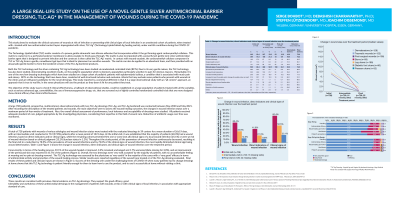Clinical Research
(CR-009) A large real life study on the use of a novel gentle silver antimicrobial barrier dressing, TLC-Ag* in the management of wounds during the COVID-19 pandemic.
Friday, April 28, 2023
7:15 PM - 8:30 PM East Coast USA Time

Introduction: This study aimed to evaluate the management of an unselected cohort of patients with wounds at risk of or with clinical signs of local infection, treated with two antimicrobial contact layers impregnated with silver (TLC-Ag healing matrix), under real-life conditions during the COVID‐19 pandemic.
Methods: A large (728 patients), prospective, multicentred, observational study with TLC-Ag dressings was conducted May 2020 and May 2021. The main outcomes included a description of the treated patients and their wound management, the changes in wound infection and wound healing outcomes over a maximum period of four weeks of treatment. Also, the overall clinical assessment of performance, local tolerance and acceptability of dressings. All patients received adequate standard of care and 24% received antibiotics at initial visit. Reduction of antibiotic usage over time was monitored.
Results: 728 patients with wounds (various) and wound infection status were evaluated in 39 centers (26 +/- 19 days). At initiation, 60.4% had wound infection, 25.1% had some but not all infection signs, 13.2% were at infection risk. 78.9% infected wounds became non infected over time, 72% wounds with some signs of infection were resolved. 92.1% wounds healed or improved over time. Periwound skin improved. Antibiotic usage went from 24% to < 4% over time. Dressing were well accepted by patients/clinicians particularly with respect to comfort and lack of pain during removal. All types of wounds studied provided similar results.
Discussion: These results are consistent with previous clinical evidence on gentle yet effective nature of the TLC-Ag dressings. They support the good efficacy, good tolerability and usefulness of these antimicrobial barrier dressings in the management of patients with wounds at risk or with clinical signs of local infection, in association with appropriate standard of care. Antibiotic usage dropped dramatically coninciding with drop in either infection, or signs and/or risk of infection. The pain at dressing removal is remarkable given that silicones are frequently used to reduce pain, yet this non silicone technology seems just as free of pain during removal.
Methods: A large (728 patients), prospective, multicentred, observational study with TLC-Ag dressings was conducted May 2020 and May 2021. The main outcomes included a description of the treated patients and their wound management, the changes in wound infection and wound healing outcomes over a maximum period of four weeks of treatment. Also, the overall clinical assessment of performance, local tolerance and acceptability of dressings. All patients received adequate standard of care and 24% received antibiotics at initial visit. Reduction of antibiotic usage over time was monitored.
Results: 728 patients with wounds (various) and wound infection status were evaluated in 39 centers (26 +/- 19 days). At initiation, 60.4% had wound infection, 25.1% had some but not all infection signs, 13.2% were at infection risk. 78.9% infected wounds became non infected over time, 72% wounds with some signs of infection were resolved. 92.1% wounds healed or improved over time. Periwound skin improved. Antibiotic usage went from 24% to < 4% over time. Dressing were well accepted by patients/clinicians particularly with respect to comfort and lack of pain during removal. All types of wounds studied provided similar results.
Discussion: These results are consistent with previous clinical evidence on gentle yet effective nature of the TLC-Ag dressings. They support the good efficacy, good tolerability and usefulness of these antimicrobial barrier dressings in the management of patients with wounds at risk or with clinical signs of local infection, in association with appropriate standard of care. Antibiotic usage dropped dramatically coninciding with drop in either infection, or signs and/or risk of infection. The pain at dressing removal is remarkable given that silicones are frequently used to reduce pain, yet this non silicone technology seems just as free of pain during removal.

.png)